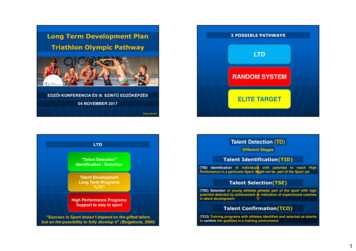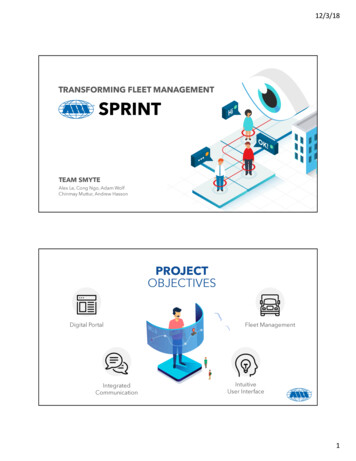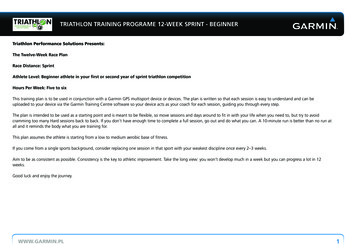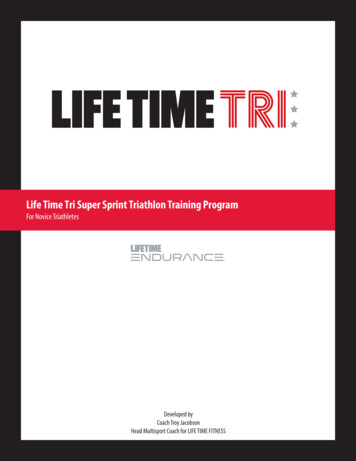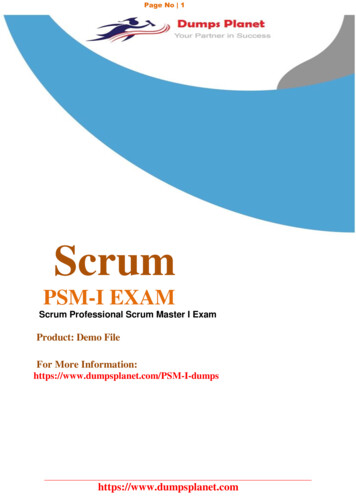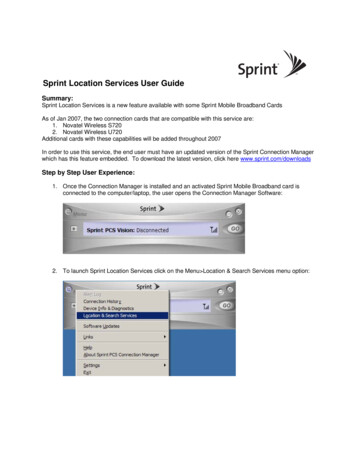
Transcription
Justin GaitlinSPRINT TRAININGMike HolmanLawrence Central High SchoolBoys State TF Champions1998 and 20052005 100m ChampionWill Glover 10.45Special TrainingUSATF HIGHPERFORMANCECOMMITTEEAthlete CenteredCoach DrivenScience BasedUnconsciously IncompetentConsciously CompetentUnconsciously CompetentPhysical Literacy“LTAD”Long Term Balance/Coordination/Neural SpeedKinesthetic cy1
Training Energy SystemsNewton’s Laws1st Law – InertiaEffortSystemPower/Capac Effectity1-2.0 secAlactic/Nerv.Alactic/Nerv.StoredATP CPPowerStarts2-5 secAlactic CPPowerAcceleration5-15 secAlactic CPPowerMax Speed1515-30 secAlacticCapacitySpeed End.End.hold 95%3030-45 45-90 secLacticCapacityAbility totolerate LA– Object in motion(rest) tends to stay inmotion 2nd Law – Acceleration– Acceleration is proportional to the forces actingupon the center of mass3rd Law – Conservation of Momentum– Equal and opposite reaction force.ANAEROBIC TRAININGSummary of 3 Energy SystemsSYSTEMPOWERWORKFUELALACTICANAEROBICVERY HIGHLOWSTORED PCLACTICANAEROBICHIGHAEROBICDEPENDS ON VERY SEGLYCOGEN &FATACTIVITYDURATION PHYSIO.DOMINATEATTRIBUTE ENERGYSOURCEShortExplosiveEffort 5 secMuscularStrength,Speed, PowerHighHigh-energyphosphates(anaer.)aer.)Short Sprint(High Power)5-10 secMuscularStrength,Speed, edSprint (HighPower)1010-60 secMuscularStrength,Speed, deratePower60 secsec-10 ,Glycolysis,AerobicPlanning TrainingSpeedSpeed-9090-100% effort of your max– Speed PowerPower-3030-60m, 4’4’-8’ rest, 300300-600m totalvolume3-6 sec– Alactic SpeedSpeed-5050-80m, 3’3’-6’ rest, 400400-600m totalvolume5-9 sec (above 9 sec, begin touching on speed endurance)– Glycolytic SpeedSpeed-4040-80m, 1’1’-4’ rest, 400400-600m totalvolumeBiomotor ApproachSprint Performance bably the most important factor, all things calHigh self imageAggressiveConfident in competitionRelaxed in competitive and pressure situations5-9 sec (less rest than above)When you stack efforts, you are now talking speedendurance2
Elite Men’s Sprint NormsHorizontalVelocitym/sStrideRate s/sStrideLengthmGroundTime GTAir TimeAT9.379.379.404.072.192.192.21.11.133Averag 42.542.56.087.113Poor12.0612.0612.09Block Spacing2 foot lengths from starting line tothe front block1 foot spacing from the front block tothe back blockFront knee angle at set position 90*Rear knee angle at set position 120*KeyKey-balance and how they feelBlock StartsQuick sideStrongest legComfortableConfidentSmoothExplosiveSuggested Block Positions forDifferent Leg LengthsLeg LengthFront 5”Block Start ConsiderationsPresetting the neuromuscular systemsystem-explosive jumps, 44-5 practice starts(research supports the fact that the 5th-6th is the fastest)Use motor set rather than a sensory set to reduce reaction timetime-motor setmeans to have the athlete focus upon their first movement, not thethe gunArms with thumbs directly under the shoulders,maximize distance ofshoulders from the trackKeep weight distributed evenly with fingers and hands forming a bridge,Shoulders directly over hands with the rear knee in contact with thegroundHead in line with the neck and back to form linear extension of the spineMuscle tension applying force against the blockblock-force application shouldcome from the gluts and hamstringshamstrings-prepre-tension desiredHips above the shoulders at set with the shins parallel at a low angle withthe ankle behind the kneeThe horizontal distance between the ankle and the hip is probablyprobably themost critical factor to evaluateForce must come form gluts and hamstrings to extend the hipsFoot dorsiflexion places the ankle joint in a mechanically advantageousposition for the next ground contact and prepre-sets muscles used in elasticforce productionLow heel recoveryrecovery-backside mechanics and concentric contractions play akey roll in starts and acceleration and gradually give way to frontsidemechanics and eccentric contractionscontractions-play a more important role in maxvelocity sprinting3
Dynamics of AccelerationDynamicChangeStride LengthShort to LongGround contact timeLong to ShortShin angle withgroundVelocitySmall to LargeStride FrequencySlow to FastHeel recoveryLow to HighSlow to FastOur MissionDecrease the timeit takes to performone stride by 0.01seconds.100 METER RACE MODEL0-30 metersdevelop push mechanics with low heelrecoveryrecovery-focus on 6 good pushes30transition/line30-60 meterstransition/line-up to run fast and tall,concentric to eccentric contractions; low heel recovery tostepstep-over mechanics60max velocity, maintenance phase, lose60-80 metersand fast80deceleration phase; medals are80-100 metersdecided in this phase, 22-6% increase in stride length, 11-9%decrease in stride frequency, 33-4% loss of speedTHERE IS A CORRECT WAY TO RUN THE RACERACE-THE MORETHE ATHELTE UNDERSTANDS THE RACE PATTERN, ANDTRAINED TO MASTER, THE CLOSER TO THEIR POTENTIALTHEY WILL RUNAccelerationBegins with “on your marks” positionThe faster the sprinter, the longer the distance required toreach maximum velocityvelocity-usually reached in 44-6 secAcceleration ability effects the distance of the accelerationphaseConcludes when the athlete reaches maximum velocityConcentrate on 6 good pushespushes-need to be strong andunderstand pushing and not pullingpulling-shin angle a keyStraight line from the head, shoulders, spine, hips, andshins to ankleAthletes will think they are staying down, when in fact, theyhave their head down and are bent at the waistwaist-their shinangle will be near 90*, which is the angle for max velocityvelocityfoot should be behind the knee to push64% of the 100m race is accelerationacceleration-should be reflected intrainingSome examples40yd – 20 strides x 0.01 0.2seconds100m – 50 x 0.01 0.5 seconds400m – 250 x 0.01 2.5 seconds1600m – 1,000 x 0.01 10 secondsMarathon – 28,000 x 0.01 33-5minutesAnalysis of Maximum VelocityGround contact is composed of an eccentric phase and aconcentric phaseEccentric phase: initiated at ground contact and ends whenthe C of M is directly over the footfoot-where the sprinter mustwork against forces that create negative horizontalaccelerationacceleration-most important phase in max velocityConcentric phase: initiated when the C of M is over the footand ends at the start of leg recoveryrecovery-contributes little if anyto max velocity, but contributes greatly to the accelerationphaseFrontside mechanics are very important in this phasephase-toeup, heel up, and knee up: ankle steps over the oppositeknee4
FI NAL THOUGHTSThe heel should be pulled from the ground up under theglut or rear hamstringToe should be dorsiflexeddorsiflexed-pull toe up toward the kneeThis compact position allows the athlete to pull the ankleover the opposite knees in a quick and explosive fashionHigh knee lift is a result of correct position of heel to glut,dorsiflexed foot and ankle over the opposite kneeAs ankle is brought over the opposite knee, the athleteshould be thinking down and back with the thigh, not thefootShin angle on contact should be 90*FROMAFAPPractice only makes perfect if you practice perfectlyNeuromuscular learninglearning-wire your athletes correctly from day oneGradual progressionprogression-in all aspects of trainingWarmWarm-up purposepurpose-rehearse maximal sprinting and race planCoaching is a visual disciplinediscipline-train your eye to watch movementAthletes must be involved to learn: ‘Tell me and I’ll remember forfora day, show me and I’ll remember for a week, involve me and I’llremember for a lifetime.’Athletes want three things: to be made competitive, to be treatedtreatedfairly, and to be allowed to have fun/the order depends on theathlete.The body was meant to push not pullSprint up hills to help correct foot contact, among other thingsTESTING30m fly with 20m acceleration zone max velocity in m/s30m crouch starting acceleration60m crouch starting acceleration and transition to fullspeed150m standing speed endurance (alactic(alactic anaerobic)350 m standing speed/special endurance (lactic anaerobic)600m standing general endurance and strength enduranceStanding triple jump starting powerSingle leg hop for 20m power and strength balance10 bounds for time and distance max speed, speedendurance, and strength possibleDRILLS5
SPRINT TRAINING Mike Holman Lawrence Central High School Boys State TF Champions 1998 and 2005 2005 100m Champion Will Glover 10.45 Justin Gaitlin Special Training USATF HIGH PERFORMANCE COMMITTEE Athlete Centered Coach Driven Science Based Unconsciously Incompetent Consciously Competent Unconsciously Competent Physical Literacy “LTAD” Long Term
